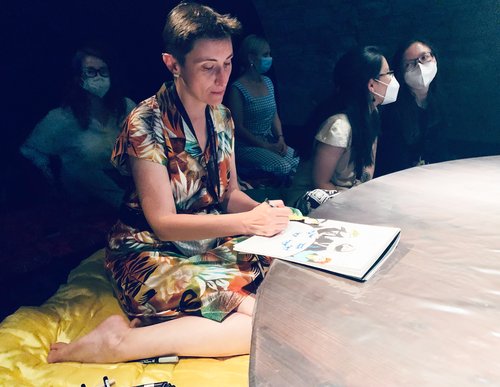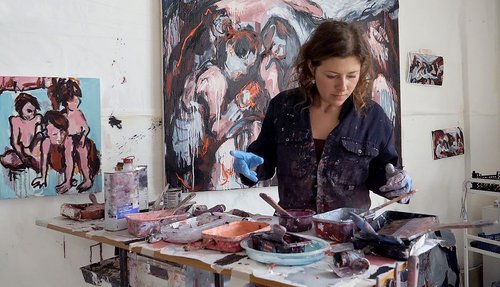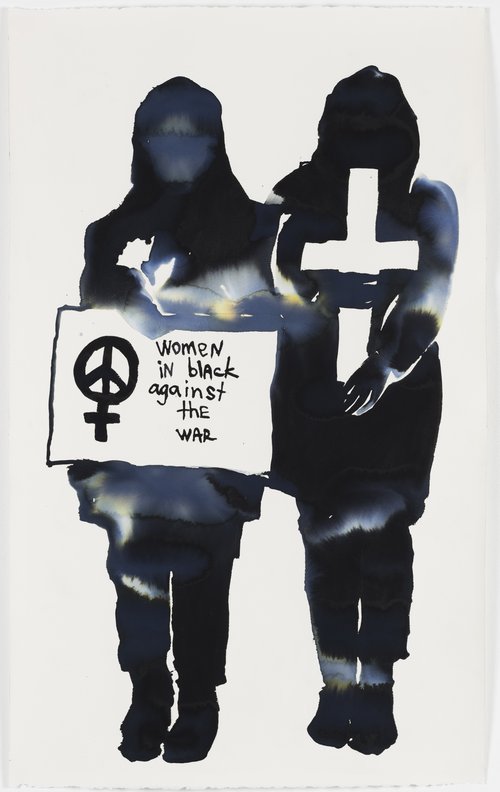Painter Leonid Tskhe Reinvents Himself

Leonid Tskhe. Figures by the water, 2016. Courtesy of Vladey
Artist Leonid Tskhe combines academic painting with an insatiable taste for experiment. Every exhibition shows a different side to his work, yet throughout his ever-evolving style, as seen in his current solo exhibition at Vladey in Moscow, he somehow manages to remain true to himself.
Originally from St Petersburg, painter Leonid Tskhe (b. 1983) left Russia two years ago to move his studio to Frankfurt and is now showing his work in Moscow at two concurrent exhibitions, a group show curated by Sergei Khachaturov called ‘Returned Look’, and the solo project, ‘Capriccio’. He has been exceptionally productive over recent months: together these two exhibitions include over twenty large-scale paintings and works on paper mostly created this Spring.
Tskhe who is ethnic Korean from his father’s side, studied at the Academic Art Lyceum in St. Petersburg before joining the graphic arts faculty of the Academy of Arts, graduating in 2007. His teacher was Andrei Pakhomov (1947–2015), a graphic artist of the ‘Leningrad school’, son of Alexei Pakhomov, a prominent figure in Russian art at the turn of the 1930s and a member of the Artists' Circle group and a refined book illustrator whose paintings of nude torsos in the spirit of neo-expressionism became known only after his death.
A decade ago, in 2013, Tskhe and his former classmates created the art group Sever-7 (North-7), which quickly grew to become an association of the most distinctive young artistic forces in St. Petersburg and certainly shaped Russian contemporary art in the 2010s. The members of Sever-7 combined the traditional media of painting, drawing and sculpture with performative practices, inventing the ‘School of Active Drawing and Performative Posing’, which according to the artists' own definition is “a method of creating a special condition-situation where it is possible to go beyond the utilitarian educational rules”. The traditional academic discipline of drawing was combined with elements of surrealism, models in absurd surroundings in paradoxical situations adopting non-classical poses. While strategizing in their work and careers, often young Russian artists build on the ‘academic trauma’ inflicted by a conservative education and turn this predicament and struggle into an important part of their own identity. Unlike many others, Tskhe's artistic practice happily circumvents the negative experiences he received as an art student and transforms them by putting them at the service of art. From 2010 to 2018, he taught drawing at the Graphics Department of the St. Petersburg Academy of Arts, radically transforming the first-year studio under his leadership into a branch of the art group Sever-7 bringing his students a contemporary artistic vision.
2015 marks the year that Tskhe's solo career took off with his first solo exhibition in the Name Gallery in his native St Petersburg with paintings and works on paper in the show all based on drawing and sketching from life. Since 2019 and a solo project ‘Boy and Tangle’, Tskhe has been collaborating with Moscow's Ovcharenko Gallery, now known as Vladey auction house and gallery.
In the autumn of 2022 he left Russia, and after enrolling at the Faculty of Art of the Hochschule für Gestaltung in Offenbach, on the outskirts of Frankfurt, he became a student of Professor Manfred Stumpf's ‘Conceptual and Nature Drawing’ course. “There is a very interesting situation in Germany where a lot of things that work well in Russia or in France just don't work. There is a sense that you cannot surprise anyone with anything. Most people want to enrol in life drawing and painting classes and you have to register well in advance because only fifteen people get chosen. In Stumpf's class there are always a lot of people who want to paint, if you arrive late in the classroom there is no space and everyone is painting. It could be a conservative twist, or maybe people want to learn skills that can make money, because paintings sell, but performance or digital art not so much”. According to Tskhe, Professor Stumpf, who retired this year, compared his drawing skills and manner to that of French post-impressionist painter Edgar Degas (1834–1917).
Over the past two years, Tskhe has mounted four major solo exhibitions in Moscow with Vladey: two for new works created in the spring of 2022 and 2024 as well as a project ‘The Risk-taker and the Magus’ in October 2023, made in collaboration with another St. Petersburg artist living outside Russia, Vlad Kulkov (b. 1986). The works were made by each artist in a shared studio in Tbilisi, with Tskhe in charge of the ‘risk-taker’ role.
Constant changeability is a habitual characteristic feature of a young artist yet Tskhe is ostensibly now at his creative peak. He has a mercurial sense of mobility and incessant development where his painting evolves and changes with each successive project. For Tskhe his milestones are not individual paintings but exhibited series of works. Exhibitions over time become for him memories or marks (notches) connected with particular moments and life events. “Life moves by itself within painting, then accompanied by a second life and all the things that exist in reality. I am interested in the process of change, experimentation per se in both life and in painting inspires me. It could be the movement itself that excites me,” he reflects.
Tskhe normally works with oil paints on canvas, using rags and stiff brushes. The paintings are created in one or two takes on the canvas, without any preliminary studies or sketches. He likes to work with music and mentions in particular the Swans. He has achieved a level of mastery of his medium which means he rarely if ever needs to correct or erase anything. “All of my recent canvases are painted without any help in the form of nature, photography or anything else, I make them completely off the top of my head. I'm most concerned with how to assemble the space. The tension of the surface, its strain has become very important now and I am paying attention to that more than before. Yes, the tension has become more important than anything else.”
After a brief monochrome period in 2021, when he worked exclusively in black paint and created grisailles, over the last year Tskhe has rebuilt and re-invented his palette: while steadily maintaining a cold colour range in his works and using black as a structural binding element, he has begun to reintroduce colour and, as he says, “takes a long time to choose paints in the shop”. “It's always more difficult with colour. With black and white it's easier in some ways where you can achieve depth, solve tonal and compositional issues, while colour gives you additional complexities. What colour? And why this colour?”
Talking about his new project, ‘Capriccio’, he says it is not only based on motifs in etchings by Francisco Goya (1746–1828). Tskhe refers to capriccio as a specific cultural form, mentioning music as well as the Baroque masters like Giovanni Battista Piranesi (1720–1778), Diego Velázquez (1599–1660), and Caravaggio (1571–1610): “There are things that excite me much more in Goya than in Peter Doig now”. Studying and living in Germany have given him new and strong artistic experiences and changed his inner perspective. In the exhibition at the Musée d'Orsay the artist was surprised at paintings hanging in one row together: Gustav Courbet (1819–1877), Edouard Manet (1832–1883) and Paul Cézanne (1839–1906) next to Alexandre Cabanel (1823–1889) and William-Adolphe Bouguereau (1825–1905). The relationship between classical cultural heritage and contemporary art as well as the notion of ‘modernity’ have developed in Russia and Western Europe in different and even distinctly opposite ways, and now as a European artist Tskhe perceives culture with more tranquillity, and therefore he has space to thinks more attentively about the subject.
“Yes, I am a classical artist,” Tskhe concludes the conversation, “I am a traditionalist in my approach to painting. To find that painting is very relevant here in Europe feels great. I would like to show my work now in the West and try to create new connections.”
Leonid Tskhe. Capriccio
Moscow, Russia
13 September – 11 October, 2024
Returned Look
Moscow, Russia
11 September – 20 October, 2024





















